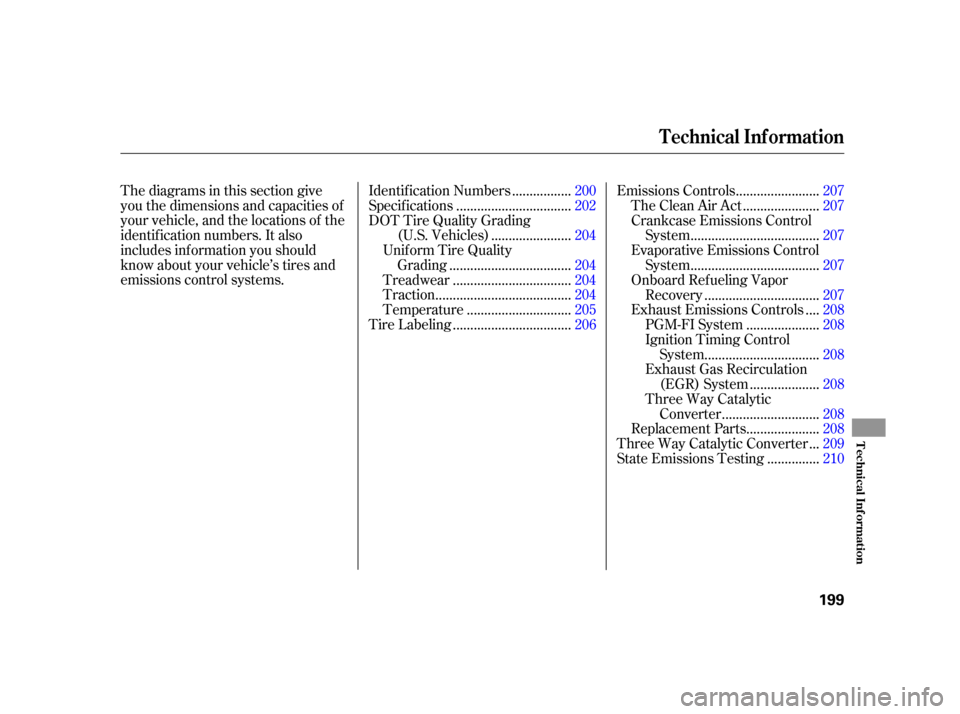2005 HONDA CIVIC HYBRID catalytic converter
[x] Cancel search: catalytic converterPage 63 of 228

You can temporarily turn of f the
Current Fuel Mileage display.This shows how much f uel you have.
It may show slightly more or less
than the actual amount.
Turn the ignition switch to ON (II)
and make sure the transmission is
in Neutral (manual) or Park
(automatic) and the parking brake
is set.
The display will turn back on when
you repeat the same procedure in
step 3. Use the Select/Reset knob to
select the odometer display.
Press and hold the Select/Reset
knob f or about 10 to 15 seconds,
then release it. The Current Fuel
Mileage display will turn of f .
1.
3. 2.
Gauges
T urning Of f the Mileage Display Fuel Gauge
Inst rument s and Cont rols
61
Avoid driving with an extremely low
f uel level. Running out of f uel could
cause the engine to misf ire, damaging
the catalytic converter.
Page 139 of 228

Always use the parking brake when
you park your vehicle. Make sure
the parking brake is set f irmly or
your vehicle may roll if it is parked
on an incline.
If your vehicle has an automatic
transmission, set the parking brake
bef ore you put the transmission in
Park. This keeps the vehicle f rom
moving and putting pressure on the
parking mechanism in the
transmission.Make sure the windows are closed.
Turn of f the lights.
Place any packages, valuables, etc.,
in the trunk or take them with you.
Lock the doors.
Never park over dry leaves, tall
grass, or other f lammable
materials. The hot three way
catalytic converter could cause
these materials to catch on fire.
If the vehicle is f acing uphill, turn
the f ront wheels away f rom the
curb. If you have a manual
transmission, put it in f irst gear.If the vehicle is f acing downhill,
turn the front wheels toward the
curb. If you have a manual
transmission, put it in reverse gear.
Make sure the parking brake is
f ully released bef ore driving away.
Driving with the parking brake
partially set can overheat or
damage the rear brakes.
Parking T ips
Parking
Driving
137
Page 201 of 228

Thediagramsinthissectiongive
you the dimensions and capacities of
your vehicle, and the locations of the
identif ication numbers. It also
includes inf ormation you should
know about your vehicle’s tires and
emissions control systems.................
Identif ication Numbers . 200
................................
Specif ications .202
DOT Tire Quality Grading ......................
(U.S. Vehicles) .204
Unif orm Tire Quality ..................................
Grading .204
.................................
Treadwear .204
......................................
Traction .204
.............................
Temperature .205
.................................
Tire Labeling .206 .......................
Emissions Controls .207
.....................
The Clean Air Act .207
Crankcase Emissions Control ....................................
System .207
Evaporative Emissions Control ....................................
System .207
Onboard Ref ueling Vapor ................................
Recovery .207
...
Exhaust Emissions Controls . 208
....................
PGM-FI System .208
Ignition Timing Control ................................
System .208
Exhaust Gas Recirculation ...................
(EGR) System . 208
Three Way Catalytic ...........................
Converter .208
....................
Replacement Parts . 208
..
Three Way Catalytic Converter . 209
..............
State Emissions Testing . 210
T echnical Inf ormat ion
T echnical Inf ormation
199
Page 210 of 228

The exhaust emissions controls
include f our systems: PGM-FI,
ignition timing control, exhaust gas
recirculation and three way catalytic
converter. These f our systems work
together to control the engine’s
combustion and minimize the
amount of HC, CO, and NOx that
comes out the tailpipe. The exhaust
emissions control systems are
separate f rom the crankcase and
evaporative emissions control
systems.This system constantly adjusts the
ignition timing, reducing the amount
of HC, CO, and NOx produced.
The three way catalytic converter is
in the exhaust system. Through
chemical reactions, it converts HC,
CO, and NOx in the engine’s exhaust
to carbon dioxide (CO ), nitrogen
(N ), and water vapor.The emissions control systems are
designed and certif ied to work to-
gether in reducing emissions to
levels that comply with the Clean Air
Act. To make sure the emissions
remain low, you should use only new
Honda replacement parts or their
equivalent f or repairs. Using lower
quality parts may increase the
emissions f rom your vehicle.
The emissions control systems are
covered by warranties separate from
the rest of your vehicle. Read your
warranty manual for more inf orma-
tion.
The exhaust gas recirculation (EGR)
system takes some of the exhaust
gas and routes it back into the intake
manif old. Adding exhaust gas to the
air/f uel mixture reduces the amount
of NOx produced when the f uel is
burned.
The PGM-FI System uses sequential
multiport f uel injection.
It has three subsystems: air intake,
engine control, and f uel control. The
transmission control module (TCM)
in automatic transmission (CVT)
vehicles or the engine control
module (ECM) in manual
transmission vehicles uses various
sensors to determine how much air is going into the engine. It then
controls how much f uel to inject
under all operating conditions.
2
2
Exhaust Emissions Controls Replacement Parts
PGM-FI Syst emIgnit ion T iming Cont rol Syst em
Exhaust Gas Recirculat ion (EGR)Syst em
Three Way Catalytic Converter
Emissions Cont rols
208
Page 211 of 228

The three way catalytic converter
contains precious metals that serve
as catalysts, promoting chemical
reactions to convert the exhaust
gasses without af f ecting the metals.
The catalytic converter is ref erred to
as a three-way catalyst, since it acts
on HC, CO, and NOx. A replacement
unit must be an original Honda part
or its equivalent.
The three way catalytic converter
must operate at a high temperature
for the chemical reactions to take
place. It can set on f ire any com-
bustible materials that come near it.
Parkyourvehicleawayfromhigh
grass, dry leaves, or other f lamma-
bles.A defective three way catalytic
converter contributes to air pollution,
and can impair your engine’s per-
f ormance. Follow these guidelines to
protect your vehicle’s three way
catalytic converter.
Always use unleaded gasoline.
Even a small amount of leaded
gasoline can contaminate the
catalyst metals, making the three
way catalytic converter inef f ective. Keep the engine tuned-up.
Have your vehicle diagnosed and
repaired if it is misf iring, back-
f iring, stalling, or otherwise not
running properly.
Three Way Catalytic Converter
T echnical Inf ormation
209
THREE WAY CATALYTIC CONVERTER
Page 226 of 228

Taillights, Changing..........................................
Bulbs .161
.
Taking Care of the Unexpected . 175
....................................
Tape Player .103
Technical Descriptions ......
DOT Tire Quality Grading . 204
.....
Emissions Control Systems . 207
..........
State Emissions Testing . 210
Three Way Catalytic ...............................
Converter .209
.................................
Tire Labeling .206
.......................
Temperature Gauge .63
..............
Tether Anchorage Points . 40
............................
Thef t Protection .106
..
Three Way Catalytic Converter . 209
..................
Tilt the Steering Wheel . 69
..........................
Time, Setting the .107
....................................
Tire Chains .172
.........
Tire, How to Change a Flat . 177
...........................
Tire Inf ormation .204
...............................................
Tires .167
..............................
Air Pressure .168
.........................
Checking Wear .170
..........................
Compact Spare .176 ......
DOT Tire Quality Grading . 204
......................................
Inf lation .168
..................................
Inspection .170
..............................
Maintenance .170
...................................
Replacing .171
......................................
Rotating .171
...........................................
Snow .172
............................
Specif ications .203
................................
Tire Chains .172
...................
Tools, Tire Changing . 177
Towing .....................................
A Trailer .140
..................
Emergency Towing . 197
...........................
Traction Devices .172
Transmission Checking Fluid Level, ..............................
Automatic .156
Checking Fluid Level, ...................................
Manual .157
..................
Fluid Selection . 156,157
..............
Identif ication Number . 201
.............
Shif ting the Automatic . 131
..................
Shif ting the Manual . 128
.....................................
Treadwear .204
.......................................
Trip Meter .60
................................................
Trunk .74 ........................................
Opening .74
...................
Open Monitor Light . 56
....................................
Turn Signals .66
Unexpected, Taking Care ..........................................
of the .175
....
Unif orm Tire Quality Grading . 204
........................
Unleaded Gasoline .112
.......
Used Oil, How to Dispose of . 153
..................................
Vanity Mirror .82
.................
Vehicle Capacity Load . 122
......................
Vehicle Dimensions .202
....
Vehicle Identif ication Number . 200
.............................
Vehicle Storage .174
........................................
Ventilation .89
.................................................
VIN .200
..................................
Viscosity, Oil .150
Index
U
T
V
VIII